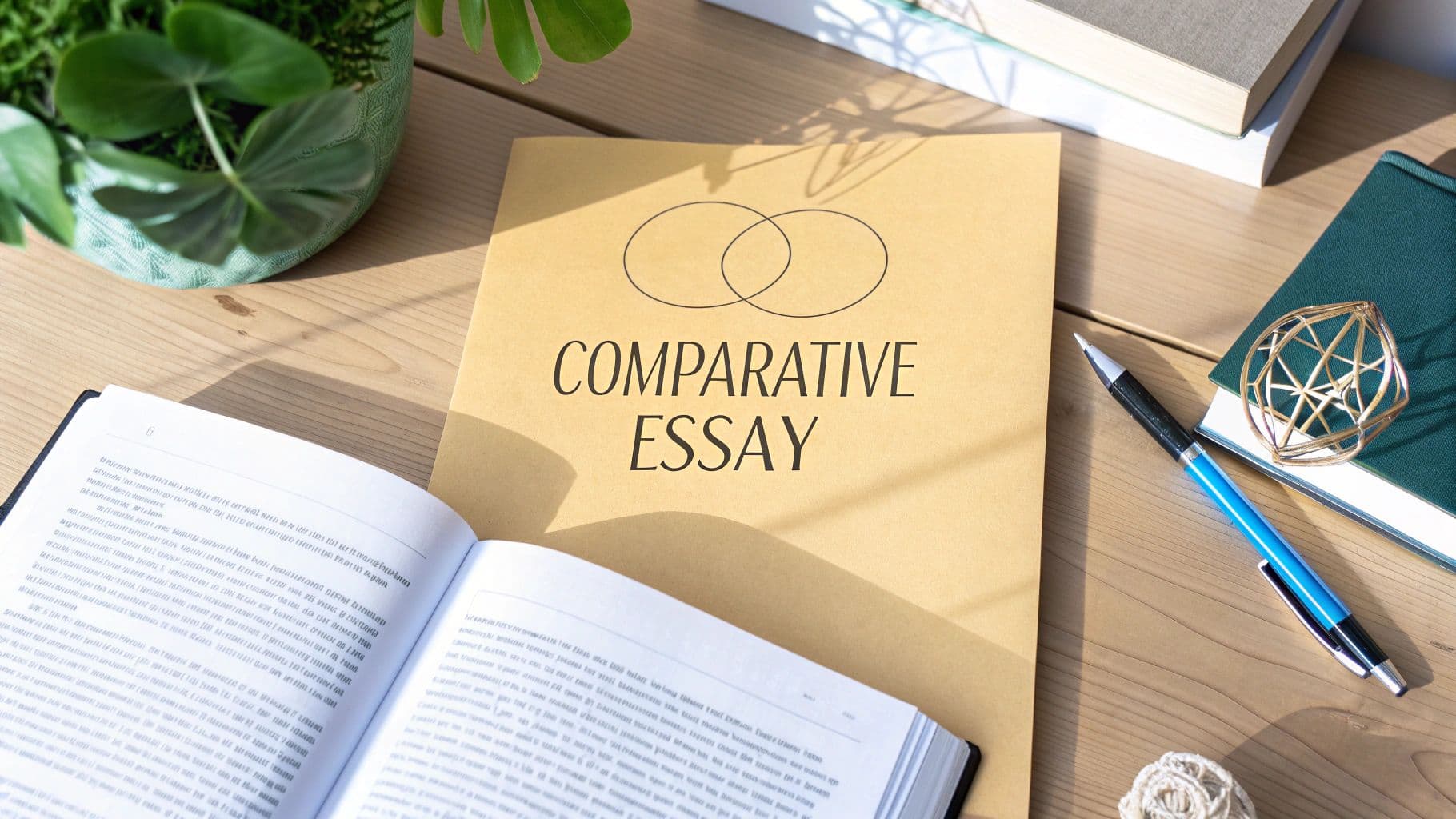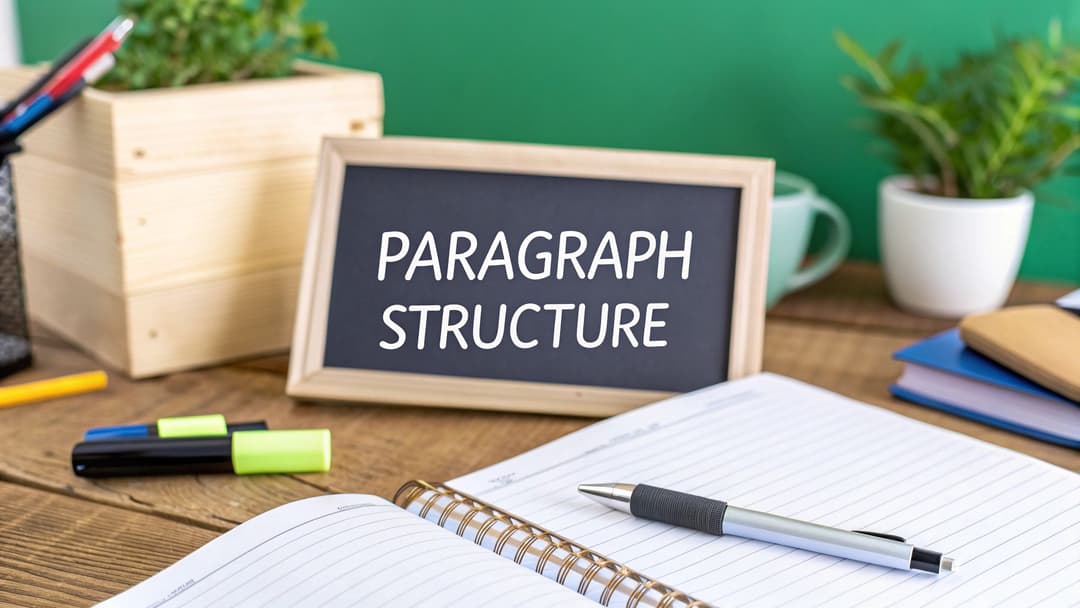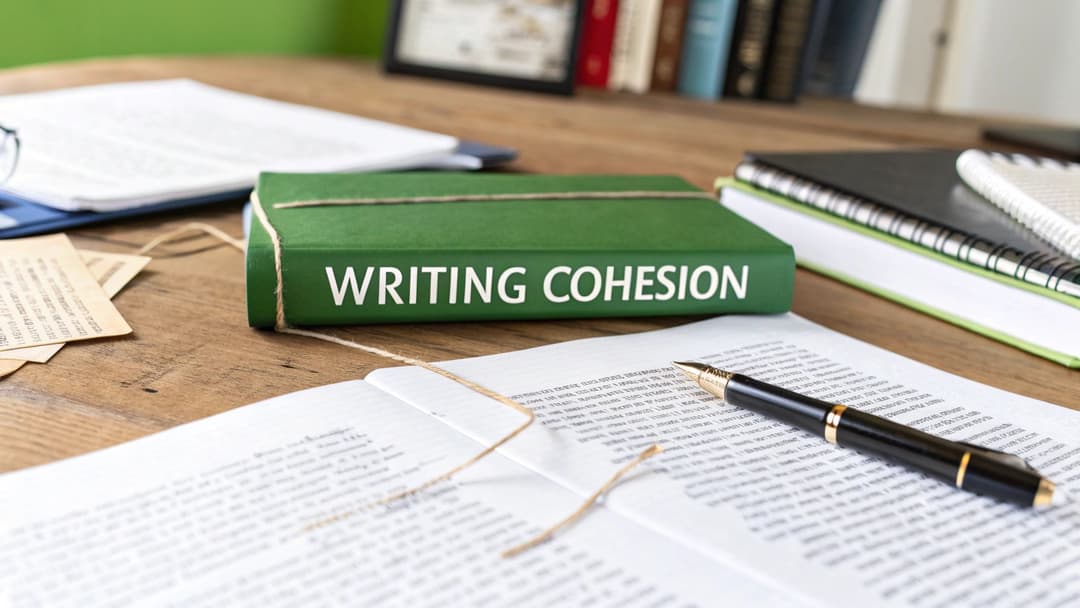
How to Write a Comparative Essay Like an Expert
November 26, 2025
So you need to write a comparative essay. Your first thought might be to just make a list—here’s what’s similar, here’s what’s different. But a great comparative essay goes much deeper than that.
You’re not just listing facts; you're building an argument. The goal is to take two subjects—maybe two novels, a couple of historical events, or even competing scientific theories—and analyze them to reveal a connection, a contrast, or a relationship that isn’t obvious at first glance.
Ultimately, a strong thesis and a clear organizational structure are what separate a simple summary from a powerful analysis.
What Makes a Great Comparative Essay
A lot of students get stuck thinking a comparative essay is just a Venn diagram turned into paragraph form. While that's a decent way to brainstorm, it’s only the beginning.
A truly sharp essay uses comparison as a tool for analysis, not just description. You're not there to state the obvious. You’re there to illuminate something new for your reader, to show them a relationship between your subjects they might never have noticed on their own.

Think of it this way: saying apples and oranges are both fruits is just description. That gets you a C, maybe. Analyzing how their different growing climates, nutritional value, and place in global trade reveal two distinct agricultural philosophies? That's a comparative analysis. You're making a real argument.
Moving from Description to Analysis
The biggest hurdle for most writers is making the jump from just listing points to actually analyzing them.
A descriptive statement sounds like this: "George Orwell's 1984 and Aldous Huxley's Brave New World both depict dystopian societies." True, but so what?
An analytical argument, on the other hand, makes a claim: "While both 1984 and Brave New World warn of dystopian futures, Orwell’s vision is rooted in state-sponsored fear, whereas Huxley’s is built on manufactured pleasure, revealing two distinct paths to societal control." See the difference? Now we have a specific argument to prove.
There's a reason this skill is so heavily emphasized in schools. By 2020, surveys found that nearly 85% of high school English teachers globally see the comparative essay as a crucial assignment for building critical thinking. You can dig into more data on international student study trends to see just how widespread this is.
The real purpose of a comparative essay is to answer the "so what?" question. Why does it matter that these two things are similar or different? What larger insight does this comparison offer?
The Two Core Structures
To build that strong analytical argument, you need a solid framework. When it comes to comparative essays, two organizational structures are the go-to methods:
- The Block Method: You discuss everything about Subject A in one big chunk, then everything about Subject B in the next, making sure to connect the points back to your main argument.
- The Point-by-Point Method: You organize the essay by the specific points of comparison, discussing both Subject A and Subject B together in each paragraph.
Picking the right structure is a strategic choice. It all depends on your topic and what kind of argument you want to make. We'll break both of these down later so you can figure out which one will give your essay the most clarity and punch. This decision is foundational—it shapes how your ideas flow and, ultimately, how convincing you are.
Laying the Groundwork for a Killer Essay
A truly powerful comparative essay doesn’t just happen. It’s built on a solid plan. Think of this planning stage as drawing up the blueprint for a house—skip it, and the whole thing is likely to collapse. This is where you turn a vague prompt into a sharp, focused argument.
Before you write a single word, you need to dissect the essay prompt. Hunt for those key action words: "compare," "contrast," "analyze," or "evaluate." Is your instructor asking you to focus more on the similarities? The differences? Or maybe the relationship between them? Getting this right from the start saves you from writing a brilliant essay that, unfortunately, doesn't answer the actual question.
Brainstorming and Finding Your Angle
Once you're clear on the prompt, it’s time to start gathering your raw materials. This isn’t just about listing facts for each subject. You're looking for interesting, non-obvious connections that can fuel a compelling argument.
You can't go wrong with some classic brainstorming tools here:
- Venn Diagrams: These are perfect for quickly visualizing the overlap (similarities) and the unique traits (differences) between your two subjects.
- Comparison Charts: For a more structured approach, create a chart. Make columns for each subject and rows for the specific criteria you're comparing, like theme, character motivation, or historical context. This forces you to think point-by-point.
But the real magic happens when you dig deeper than surface-level facts. As you're brainstorming, try to think about the why behind your observations. While it’s a different context, some general strategies for finding content ideas can actually spark some interesting angles for an essay. Don't just list similarities; ask yourself what their implications are.
Nailing the Thesis Statement
Your thesis is the engine of your entire essay. It’s not just a statement of fact; it’s an arguable claim that you’ll spend the rest of the paper proving. A weak thesis just points out that two things are similar and different. A strong one makes a specific argument about why that comparison even matters.
A great thesis moves beyond observation to interpretation. It answers the "so what?" question, telling the reader what larger insight can be gained from comparing these two subjects.
Let's imagine you're comparing two historical revolutions.
- Weak Thesis: The French and American Revolutions had both similarities and differences. (This is just an observation, not an argument.)
- Strong Thesis: While both the French and American Revolutions were driven by a desire for liberty, the American Revolution’s focus on individual rights led to a stable republic, whereas the French Revolution’s emphasis on collective will resulted in radical instability.
See the difference? The second one offers a clear, debatable point and gives you a roadmap for your entire essay.
If you really want to get this part right, our guide on how to write a thesis statement is packed with more examples and strategies. Once you’ve finished planning, you should have a rock-solid thesis and a list of organized points, all ready to be shaped into persuasive paragraphs.
Picking the Right Structure for Your Essay
How you organize your ideas is just as important as the ideas themselves. Once you've got a sharp thesis, you need a solid framework to build your argument. For a comparative essay, this usually boils down to two heavy hitters: the Block Method and the Point-by-Point Method.
Choosing between them isn't just about personal preference. It's a strategic move that can make or break your essay's clarity and impact. One structure is fantastic for giving a big-picture overview, while the other is way better for sharp, direct comparisons.
The Block Method: A Deep Dive, One Subject at a Time
Think of the Block Method as telling two complete stories, one right after the other. First, you'll spend a few paragraphs covering every important aspect of Subject A.
Once you’ve said everything you need to about Subject A, you switch gears. The next block of paragraphs is dedicated entirely to Subject B, making sure to discuss the exact same points you covered for Subject A, and in the same order. This creates a really clear parallel for your reader to follow.
This method is your best friend when your subjects are complex. It lets you paint a full, uninterrupted picture of each one before you start drawing your big comparative conclusions in the final paragraphs.
Let's imagine you're comparing the films Blade Runner and The Matrix. Using the Block Method, your essay might look like this:
- Introduction: Your thesis, arguing how they present different views on humanity's relationship with technology.
- Block 1 (All about Blade Runner):
- A paragraph on its visual style.
- A paragraph on how it defines humanity.
- A paragraph on the role of corporate power.
- Block 2 (All about The Matrix):
- A paragraph on its visual style, directly connecting back to Blade Runner.
- A paragraph on its definition of humanity, contrasting it with Blade Runner.
- A paragraph on corporate power, comparing it to what you saw in Blade Runner.
- Conclusion: Where you tie it all together and synthesize your arguments.
The biggest risk? The essay can feel a bit disjointed, like two separate mini-essays stitched together. You're relying heavily on that conclusion to do the heavy lifting of the comparison.
The Point-by-Point Method: Weaving Your Argument Together
Now for the Point-by-Point Method. Instead of splitting up your subjects, this structure organizes the essay around your key points of comparison. Each body paragraph zeroes in on one of those points, discussing both Subject A and Subject B together, right there in the same paragraph.
This is where all that brainstorming you did earlier really pays off.

As you can see, the points you brainstorm directly shape your thesis, which then helps you decide which structure will work best.
Let’s go back to our film example. A Point-by-Point essay would look totally different:
- Introduction: The same great thesis as before.
- Body Paragraph 1 (Visual Aesthetics): Here, you'd discuss the visual styles of Blade Runner and The Matrix in the same paragraph, showing their similarities and differences side-by-side.
- Body Paragraph 2 (Definition of Humanity): You'd compare how both films explore this theme within the same paragraph.
- Body Paragraph 3 (Corporate Power): You’d contrast the role corporations play in both narratives, again, all in one place.
- Conclusion: A summary of your interwoven analysis.
This approach keeps the comparison front and center, making it impossible for your reader to miss the connections you’re making. It’s no surprise that around 60% of comparative essays use this structure—it just makes for a more integrated and persuasive argument. If you're curious, you can explore more insights on comparative essay writing trends to see why it's so popular.
Choosing Your Comparative Essay Structure
Still not sure which way to go? This table breaks down the core differences to help you decide.
| Feature | Block Method | Point-by-Point Method |
|---|---|---|
| Best For | Complex subjects needing detailed, individual explanation. | Direct, continuous comparison of specific points. |
| Flow | Can feel like two separate essays. Comparison is less direct. | Fully integrated. The comparison is constant and clear. |
| Clarity | Good for introducing unfamiliar topics one at a time. | Excellent for highlighting subtle similarities and differences. |
| Biggest Risk | The actual comparison gets delayed until the end. | Can feel repetitive if transitions aren't handled well. |
| Paragraphs | Each paragraph focuses on one aspect of one subject. | Each paragraph discusses both subjects through one point. |
Ultimately, the Point-by-Point method is often the stronger, more sophisticated choice. But if your subjects are so different or complicated that your reader needs a full rundown of one before moving to the next, the Block Method can be a lifesaver.
Writing Body Paragraphs That Persuade
This is where your argument truly comes to life. Think of your thesis as the engine of your essay; the body paragraphs are the gears that move it forward. Each paragraph needs to be its own self-contained unit, proving one specific part of your bigger claim by connecting your evidence back to your thesis with sharp, clear analysis.
You're not just listing facts here. You're building a case, piece by piece, to convince your reader that your interpretation holds water.

The Anatomy of a Powerful Paragraph
Every great body paragraph in a comparative essay follows a simple but powerful structure. I like to think of it as a formula: Point, Evidence, Analysis, Link. This little framework keeps every paragraph focused, well-supported, and locked into your main argument.
Let's break that down:
- Point: Kick things off with a strong topic sentence. This sentence should introduce the specific point of comparison you're tackling in the paragraph and make a mini-claim that supports your overall thesis.
- Evidence: Next, bring in the proof for both Subject A and Subject B. This could be a quote from a text, a statistic from a study, or a specific detail from your sources that backs up your point.
- Analysis: This is the most important part. You have to explain why the evidence matters. Don't just drop a quote and walk away—unpack it. How does this piece of evidence prove your paragraph's point? What does the similarity or difference you've highlighted actually reveal?
- Link: Wrap it up by briefly tying the paragraph's point back to your main thesis or setting up a smooth transition into the next point.
Nailing that topic sentence is the foundation of the whole structure. If you want to really sharpen that skill, check out our guide on writing effective topic sentences for body paragraphs.
Bringing It All Together with Analysis
The difference between a B-grade essay and an A-grade one almost always comes down to the quality of the analysis. Presenting evidence shows what you know; analyzing it shows how you think. Your analysis is the "so what?" of the paragraph—it explains the real significance of the comparison you're making.
Analysis is your chance to go beyond the obvious. It’s where you explain the implications of the similarities and differences, connecting the dots for your reader and showing you have a deeper understanding of the material.
For example, don't just state that two novels both use a first-person narrator. Analyze why that choice matters. Does the narration create a sense of intimacy in one book but unreliability in the other? That's analysis.
The Art of the Smooth Transition
Finally, let's talk about transitions. They're the glue holding your entire essay together. Without them, you just have a collection of disconnected points. Good transitions ensure your reader can follow your train of thought as you move from one idea to the next, turning your paragraphs into a single, cohesive argument.
Powerful Transition Words for Comparison:
- To show similarity: Similarly, Likewise, In the same way, Both
- To show contrast: In contrast, However, On the other hand, Whereas, Conversely
- To add information: Additionally, Furthermore, Moreover
Using these words signals the relationship between your ideas. Starting a sentence with "On the other hand..." immediately tells your reader you're about to pivot to a key difference. This makes your argument clearer, more professional, and ensures your essay flows seamlessly from one idea to the next.
Concluding and Polishing Your Essay
You’ve built your case, laid out your evidence, and woven a compelling argument. Now it’s time to bring it all home. A great conclusion does more than just slam the brakes on your essay; it synthesizes your points and leaves your reader with a lasting impression.
The most common trap is simply restating your thesis word-for-word. Don't do it. Instead, rephrase it with the fresh perspective you've gained from your analysis. Briefly recap the key comparative points you made, reminding the reader how they all add up to prove your larger argument.
Answering the "So What?" Question
Ultimately, the most critical job of your conclusion is to answer the "so what?" question. Why does this comparison even matter? What larger insight or implication have you uncovered? This final thought is what elevates your essay from a good summary to a great piece of analysis.
For example, after comparing two historical revolutions, your conclusion might point to a broader pattern in how societies pursue liberty. That final, insightful takeaway gives your reader something to chew on long after they've finished reading. If you need more guidance on crafting that powerful final paragraph, our article on how to write a conclusion paragraph offers detailed strategies.
Your conclusion is the last word. Make it count by offering a final, synthetic thought that highlights the significance of your comparative analysis, leaving a lasting and intelligent impression on your reader.
Revising Your Comparative Essay
With your first draft complete, it’s time to shift gears from writer to editor. Revision isn't just about catching typos; it's about sharpening your argument and making sure every part of your essay pulls its weight.
I find a focused checklist helps keep the review process on track.
- Thesis Strength: Is your thesis a real claim, not just an observation? Does the rest of the essay actually support it? Be honest with yourself here.
- Logical Flow: Does the essay move smoothly from one point to the next? Your transitions are the glue holding this all together, especially between points of comparison.
- Consistent Comparison: Did you give balanced attention to both subjects? Whether you used the block or point-by-point method, the comparison needs to feel consistent and clear, not lopsided.
- Evidence and Analysis: Is every claim backed by specific evidence? Even more importantly, did you analyze that evidence to explain why it matters to your argument?
Using Modern Tools Ethically
Today’s writing landscape includes a new set of tools, and it’s impossible to ignore. Search data shows that interest in terms like 'AI essay writer' surged by a staggering 537% from 2022 to early 2025, while searches for traditional 'essay writing services' dropped.
This shows a new reality in academic writing. It also means understanding how to use these tools responsibly is more important than ever. You can learn more about these evolving search trends and what they mean for students.
Use AI for what it's good at—brainstorming ideas, checking grammar, or rephrasing a clunky sentence. But the core analysis, the critical thinking, and the unique argument must be yours. The whole point of a comparative essay is to develop your ability to think, not just to produce a document. Polish your work, but make sure the final product is a true reflection of your own intellectual effort.
Common Questions About Comparative Essays
Even with a solid plan, a few questions always pop up when you sit down to write a comparative essay. It's totally normal. Let's walk through some of the most common hurdles so you can tackle your next assignment with confidence.
One of the biggest anxieties is about fairness. How do you give both subjects equal attention without the essay feeling like a constant back-and-forth? It all comes down to balance. If you spend three sentences on a point for Subject A, aim for roughly the same when you discuss Subject B. This simple gut check keeps your argument from feeling lopsided or biased.
What If My Subjects Are Very Different?
That’s not a problem—it’s an opportunity. A great comparative essay doesn't need two subjects that are nearly identical. In fact, huge differences often lead to the most interesting and insightful analysis.
The goal isn't just to list those differences. You need to dig deeper and explore what they actually reveal.
Ask yourself:
- Why do these differences even exist?
- What larger cultural, historical, or thematic ideas do these contrasts bring to light?
- Does one subject’s approach challenge or illuminate the other’s in a surprising way?
Focus on the implications of the differences. That’s where you’ll build a powerful argument.
How Many Points of Comparison Do I Need?
There’s no magic number here. Quality always beats quantity. A well-developed essay that dives deep into two or three significant points is far more persuasive than a shallow one that just scratches the surface of ten different ideas.
Your goal is depth, not a laundry list. Pick the points that most directly support your thesis and allow you to bring in detailed evidence. A focused approach ensures each comparison meaningfully contributes to your overall argument.
Remember, the point of the essay is not document production; it's a way for you to figure out what you think. The struggle to find the right points and analyze them is where the real learning happens.
If you find yourself with too many ideas, try grouping them into larger themes. This will help you stay focused on the most impactful comparisons—the ones that will make your essay stand out.
Ready to make sure your final draft sounds polished, clear, and human? Natural Write can help. Our free tool instantly refines AI-generated or clunky text, ensuring your essay passes AI detection while preserving your unique ideas. Perfect your tone and clarity with one click at https://naturalwrite.com.


